Visiting the Lofoten Islands with its craggy mountainous landscape is something you’ll never forget. To help you prepare, from the do’s and don’ts, here’s everything you should know before visiting the world’s most beautiful archipelago.
For years, I’ve dreamed about visiting the Lofoten Islands. Whilst researching I found very little information on the practicalities on getting to Lofoten, how to prepare, and what to expect so I decided to create this in-depth guide full of useful Lofoten travel tips so you don’t have to wing it or get caught out. Here are my 23 top tips for visiting the Lofoten Islands in Norway.
1. Dress warm and carry a spare pair of socks
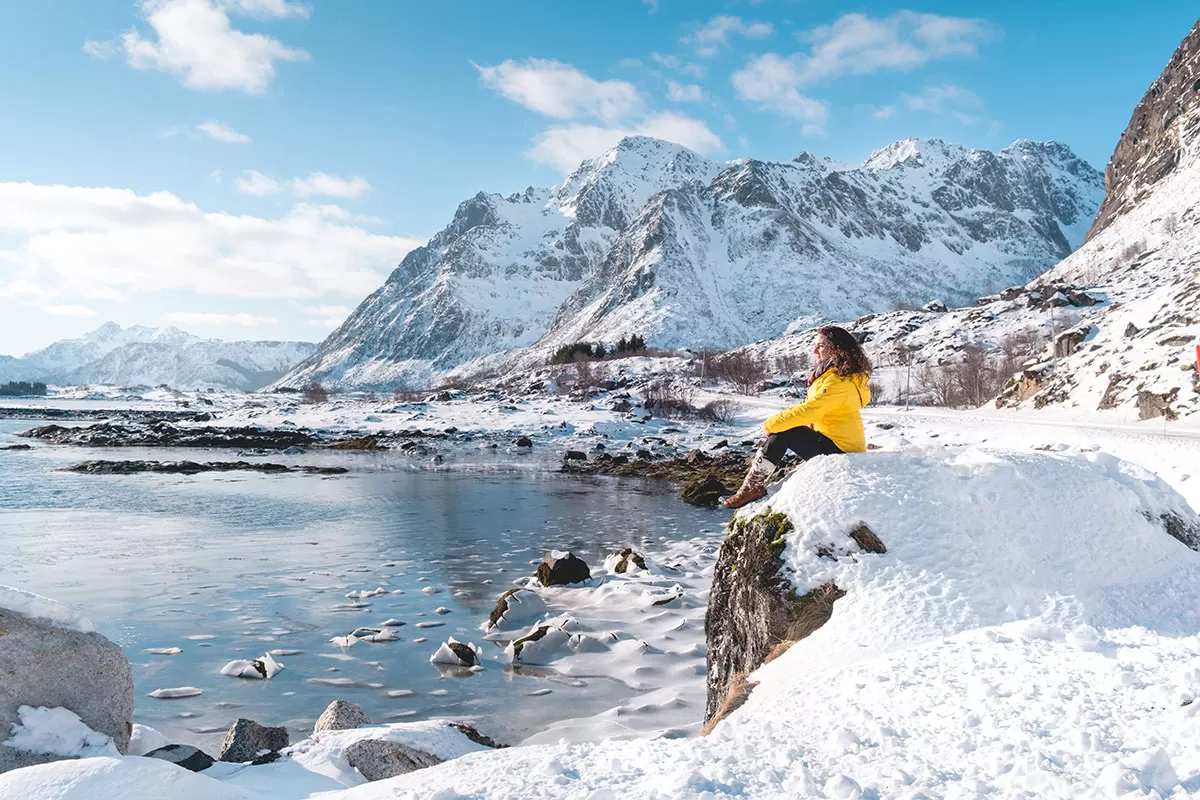
During Winter and even into Spring, there is still plenty of snow on the ground. If you don’t have the proper footwear such as these Sorel boots for men and women’s, your feet will get wet from sweating or from snow entering your shoes so it’s a good idea to carry a spare pair of thermal socks. For more details on what to wear, check out my full winter clothing packing list guide.
Wearing gaiters and is also highly recommended, especially if you go hiking in winter.
2. Beware of Avalanches
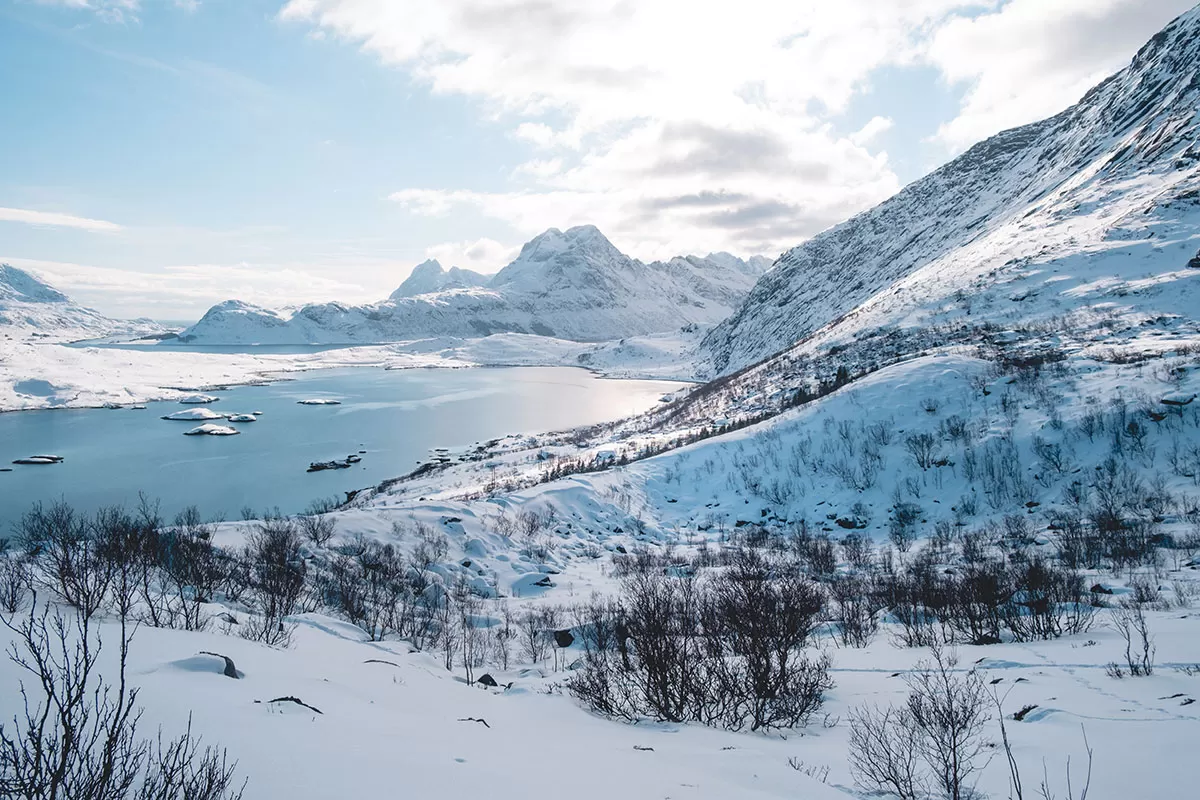
As an Australia, worrying about avalanches is not something I would instinctively consider whilst visiting any cold climate region, which is why I feel it’s important to mention here, just in case you’re like me.
Learning about avalanche safety is something Norwegian’s learn at school and is ingrained in them. Sadly though, 168 people were in one way or another involved in avalanches in Norway last winter and an average of 5 people are killed on Norwegian mountains each year with foreign visitors making up the majority.
Your safest bet is to always go on an organised hike or ski trip with an experienced local guide. They will be well-versed on local conditions and will know when conditions are safe.
If you do decide to go it alone, please ask some locals before setting out. Plan your trip using the avalanche forecast varsom.no.
You can also download the REGOBS-app from App store or Android store. With REGOBS, you can share and access information about local conditions with other people, as well as download an offline inclination map. Typically, any terrain that is steeper than 30 degrees has the potential for avalanches to occur.
In addition, you should keep an eye on the weather conditions in your area using yr.no and senorge.no. Finally, always bring an avalanche transmitter and transceiver, a probe and a shovel when you are in avalanche terrain.
3. Shops are closed on Sundays
Back home you might save your weekly shop for Sunday, but in the rural Lofoten islands (and in Norway in general), the supermarkets are closed. Only service stations and convenience stores are open.
Only in larger towns (of which there are very few) will you find grocery stores that are open on Sundays. Shops are open every other day from 10:00 to 17:00 (Thursday until 18:00) and shopping centres have extended opening hours. This is a good one keep this in mind as you plan your meals.
4. Buy your alcohol from a Vinmonopolet
If during your trip you fancy drinking a bottle of wine or a spirit and mixer, then you’ll need to find a Vinmonopolet (English: The Wine Monopoly). Vinmonopolet is a government-owned alcoholic beverage retailer and the only company allowed to sell beverages containing an alcohol content higher than 4.75% in Norway.
To help you find your nearest Vinmonopolet outlet, you can use this app. It’s worth noting that Vinmonopolet typically close earlier than other shops, on weekdays they close at 6 pm and Saturdays at 3 pm.
5. Best way to get to Lofoten islands
By Plane
The Lofoten Islands has two main airports, Svolvær and Leknes, which service domestic destinations only. Svolvaer connects Bodø, Oslo, Røst, Stokmarknes and Leknes connects Bodø, Oslo, Tromsø. The closest international airport you can access by road (and has more flight times) is Harstad/Narvik Airport located in Evenes.
By Car
The E10 will be your best friend during your trip as it connects the many of the islands in the Lofoten archipelago via a two-way road. Starting in Luleå in Sweden, the E10 passes through Leknes, Svolvær, Gullesfjordbotn, Evenes, and ends in Å in the Lofoten islands. Å, incidentally, is the last letter of the Norwegian alphabet and the last town you can arrive to by car in Lofoten. Compare prices and hire your car here.
By Ferry
The more traditional approach to reach Lofoten from the mainland is by car ferry by Bødo.
For more details on how to get to Lofoten, check out my in-depth guide.
6. Best way to get around Lofoten is to hire a car
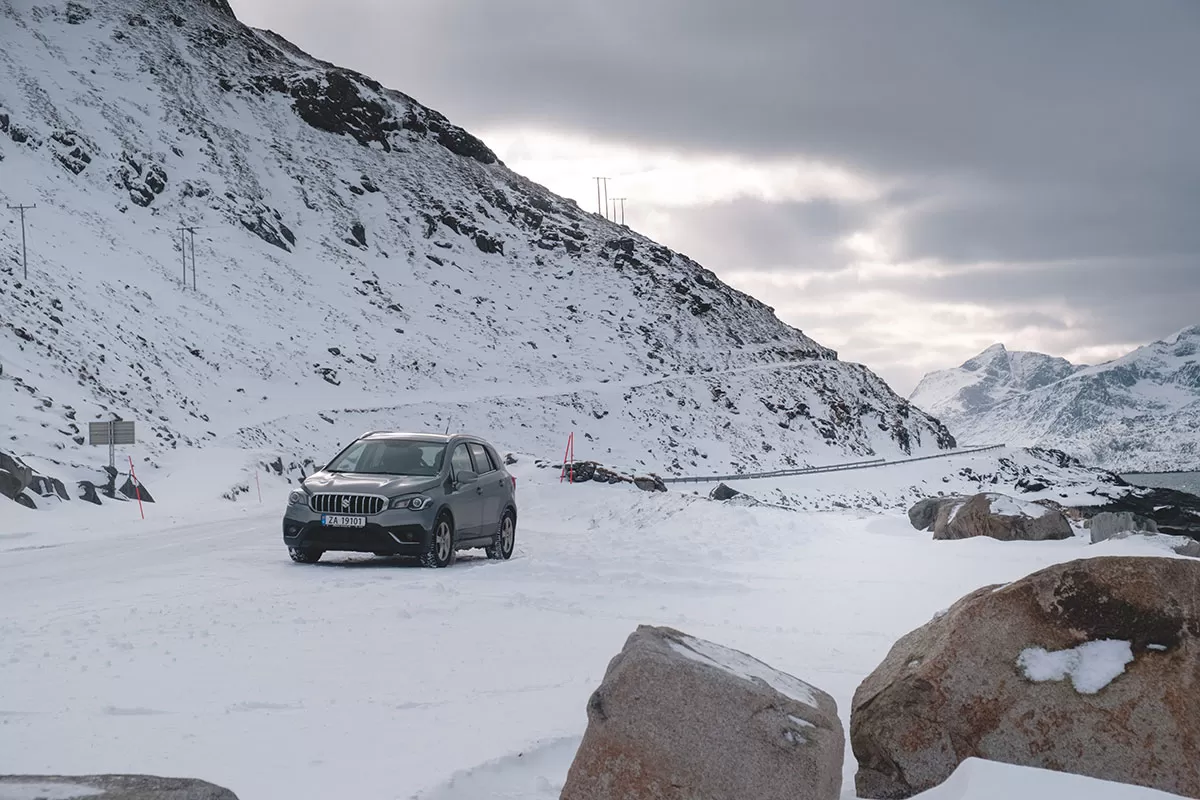
Car rental is available at Svolvaer, Leknes and Evenes airports. Since I was travelling internationally, I flew from London-Gatwick with a connection in Oslo then to Evenes which I picked up a SUV from here then jumped on the E10.
Hiring a car in Lofoten is a very popular choice and cars book up quickly. Book here at least 1-2 months in advance to avoid disappointment.
Here are some more common Norwegian motoring terms which are handy to be aware of:
- Utgiftsvei – toll-road
- Bensinstasjon – petrolstation
- Bilutleie firma – car rental agency
- Blyfri bensin – unleaded petrol
- Bomstasjon – toll
- Innkjørsel – entrance
- Motorolje – motor oil
- Motorvei – highway
- Omkjøring – detour
- Parkering – parking
- Politi – police
- Politistasjon – police station
- Sykehus – hospital
- Utkjørsel – exit
For more details on how to get around Lofoten, check out my in-depth guide here.
7. Get off the E10 and explore the side roads
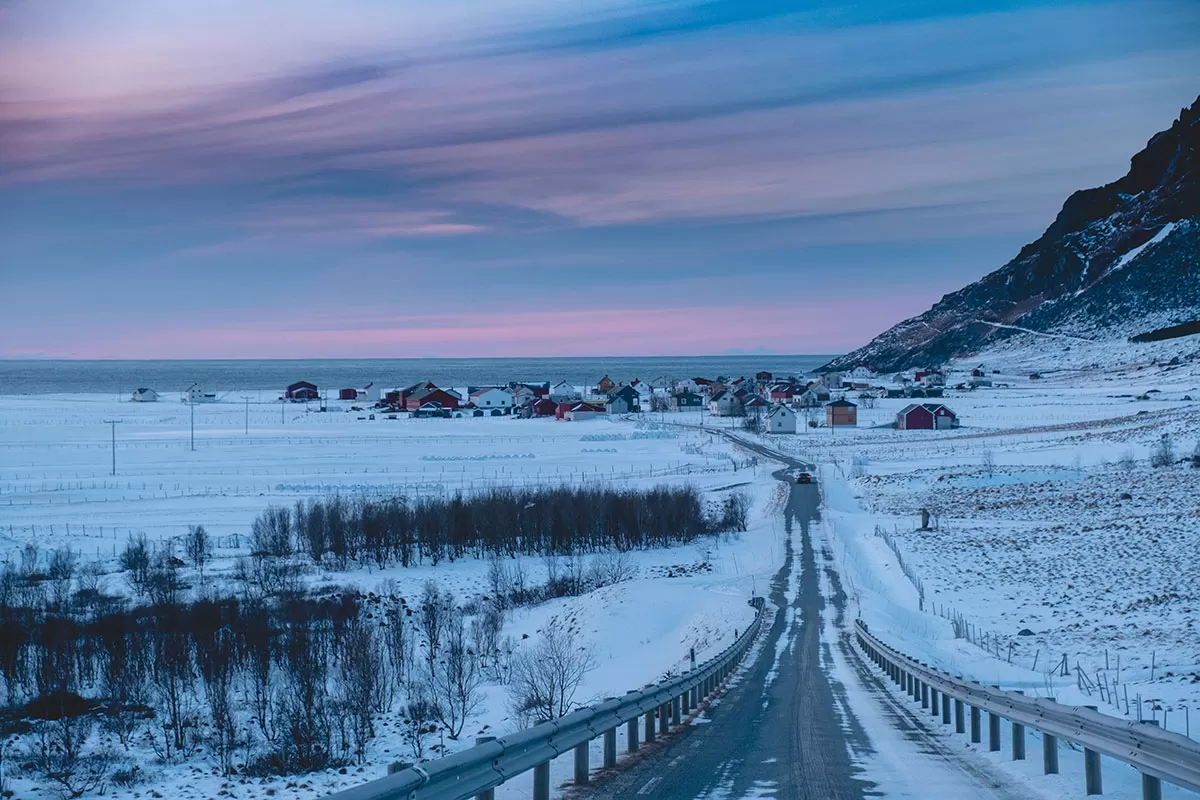
8. Make sure your car is safe and winter proof
Whenever you hire a car in Norway, it will automatically come equipped with winter tyres with spikes and an ice scraper (look out for a ‘winter charge’ on your invoice) but it’s worth checking everything has been safely installed.
During my stay at Hattvika Lodge, our host Kristian explained to us how he helped a guest with their rental car when he discovered that their tyres were different sizes, making it potentially very dangerous to drive. When you pick up your car, double check that everything looks ok just to be sure. Also, check your tyre tread isn’t worn down as this will cause accidents in any conditions.
9. Keep an eye out for black ice
Again, as an Aussie, the concept of black ice is not something you hear about until you visit a country like Norway. Since you’ll be driving in Lofoten (or anywhere cold and snowy), then you need to know what black ice is and how to spot it.
Black ice is a thin coating of ice that forms on roads in environments below 0 °C (32 °F). The ice itself isn’t black, but transparent so that you can see the road beneath it. Black ice is difficult to spot compared with snow, frozen slush, or thicker ice layers which makes driving, cycling or walking very dangerous.
Black ice usually forms at night or in the early morning when the temperatures are at their lowest Black ice will also form due to the heat of tyres on the road together with the freezing temperature.
How to spot black ice:
- If a car ahead of your suddenly swerve for no apparent reason, black ice is a likely cause
- In the right lighting conditions, black ice can be seen, look out for very smooth glossy sheets.
What do to if you encounter black ice:
- Lift your feet off the accelerator completely, this will give you more control
- DON’T hit the brakes, they will cause skidding or losing control
- Let the care pass over the ice and try keeping the steering wheel straight
- If you feel the back end of your car sliding left or right, make a very gentle turn of the steering wheel in the same direction. If you steer in the opposite direction, you risk skidding or losing control.
10. Wear reflective bands
No matter how dark, cold, or how much it’s snowing you will always find Norwegians out and about walking their dogs, going for a walk, or running. Polar Night is no excuse for a Norwegian to stay inside. To ensure they stay safe when near a road, Norwegians will wear these reflective bands on their arms so they are highly visible to drivers. Again, this is something most visitor don’t know about, let allow implement, so here we are.
When you walk alongside a trafficked road, you should walk on the left side so you can see the cars coming towards you. In which case, if you only have one, it makes sense to put the reflective band on the right arm.
11. Wear sunglasses
I travelled to Lofoten in March, shortly after the end of Polar Night, so the sunny days mixed with snowy landscapes exposed me to another very Norwegian problem, snow blindness. *Sigh* I’m really starting to show my ignorance but hey ho, you live and learn.
While sunny skies over a white Lofoten landscape is magical, it can also be very painful and cause temporary loss of vision due to overexposure to the sun’s UV rays. Make sure you wear your sunglasses folks, I learned this one the hard way while I was filming my 6 month Norwegian language class video.
12. Best time to see the Northern Lights in Lofoten is between November-March
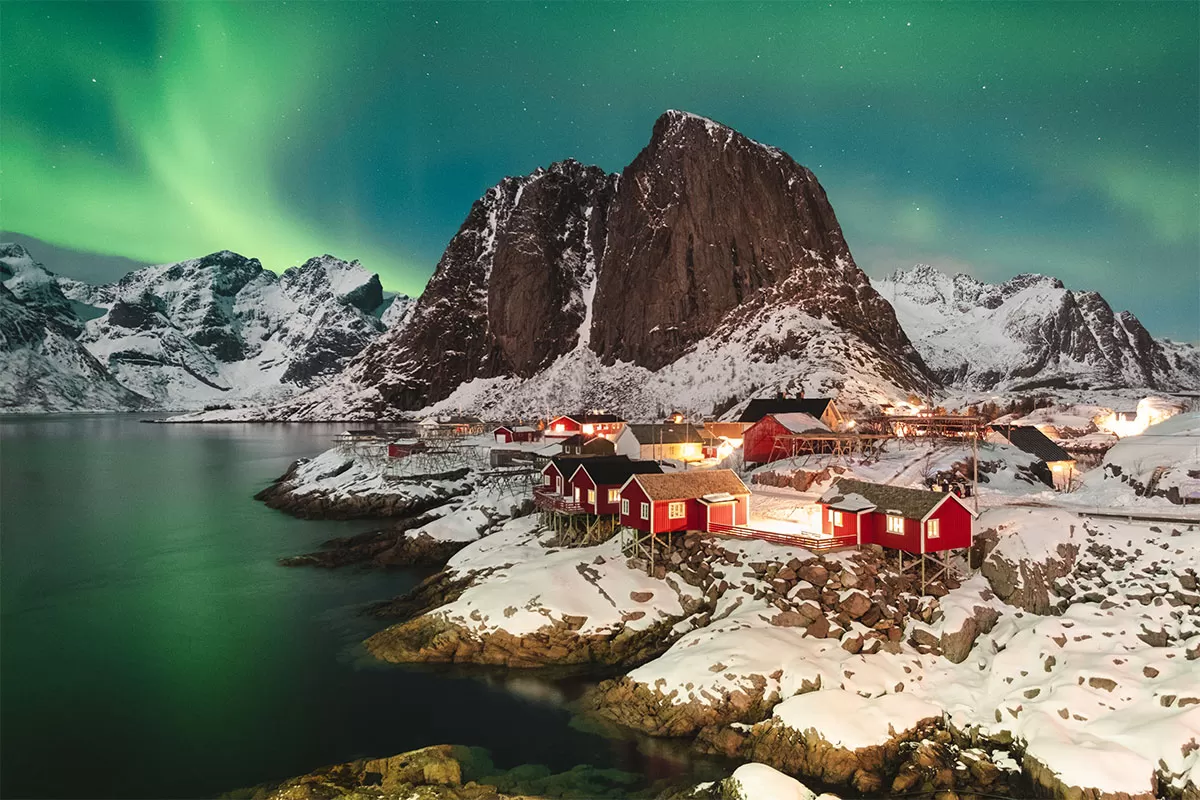
Thanks to its location over the Arctic Circle, Lofoten is situated in an ideal spot to see nature’s spectacular light show. While the lights are active all year around, the best period to see them is during Polar Night, a period of the year known where the sun never rises above the horizon. Polar night starts December 9th and lasts until January 4th.
Having said that, when I visited in March, I saw the Northern Lights and a friend who visited early-April also saw them. If the sky is dark and clear, then your chances are great. Anytime after late April your chances are slim as the season of the midnight sun ramps up.
Going to Lofoten? Don’t miss 28 Unique Things to Do in Lofoten Before You Die [A Comprehensive Guide]
13. Best time to see the midnight sun in Lofoten is between late May and mid July
Another arctic phenomena is the midnight sun which is the polar opposite (pun intended) of polar night, where the sun never dips below the horizon, even at midnight. If you’re right on the Arctic Circle itself, this only happens once a year on the summer solstice, but since Lofoten is located higher up you’ll have a larger window of time to experience it. The midnight sun in Lofoten typically starts May 26th and lasts until July 17th. In Tromsø, the best time starts late May to late July.
14. Learn some Norwegian
While you don’t need to be fluent in Norwegian, knowing a few choice words and phrases can go a long way. Generally, Norwegians are excellent English speakers, but it’s polite and kind to meet them halfway. If you only remember ‘hei’ (hello), ‘takk’ (thank you), and ‘ha det bra’ (goodbye) I’ll be happy.
Get my free Norwegian travel phrase guide with pronunciation to get started.
15. Best time to visit the Lofoten Islands depends on what you want to do
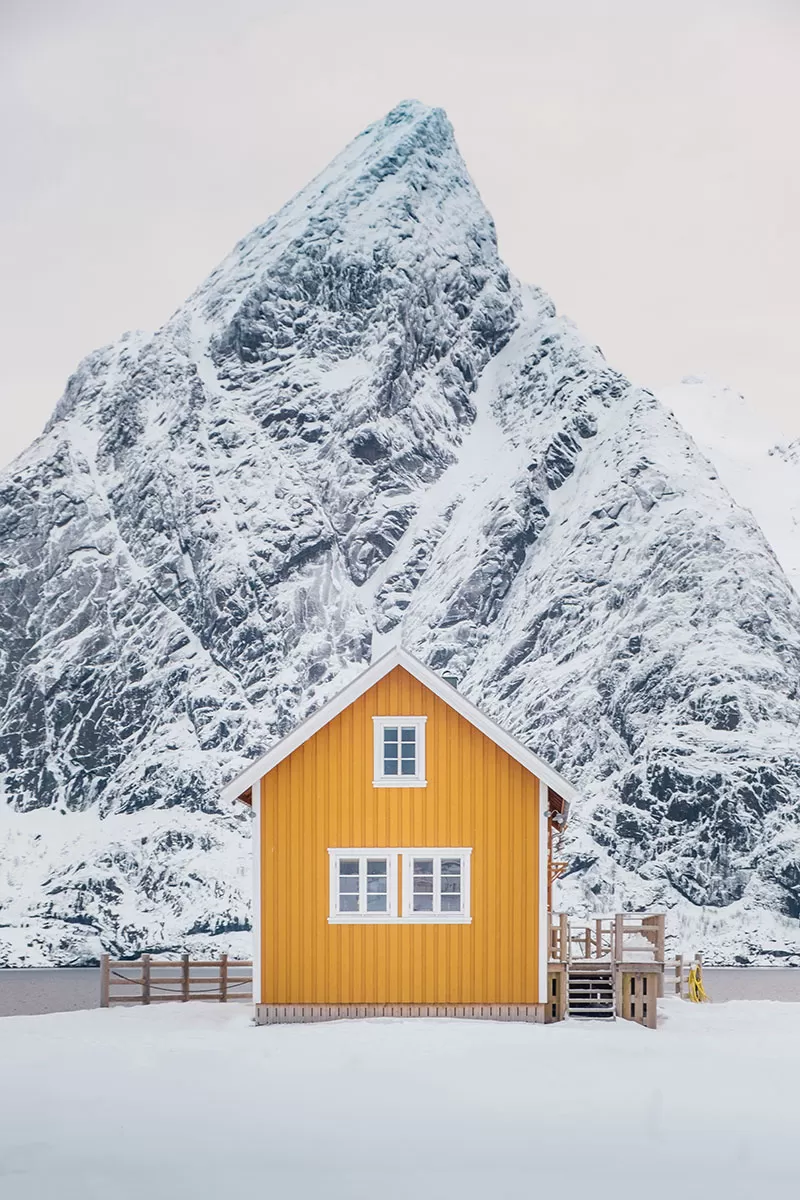
Best time for photography
For photographers seeking the soft arctic light and a pretty snow-covered landscape then between January and March is perfect.
Best time for hiking
If you want to go hiking, then you’ll need to wait at least until late May. For many inland hikes, there is still be a lot of snow on the ground which makes the hike significantly more difficult so you’ll need to play each hike by ear and check local conditions. I hiked Trolltunga at the end of May which made an already tough hike even more challenging.
For hikes with less snow on the ground, stick to coastal areas. According to Cody at 68North, spring is also a period of rockfall and avalanches, so ensure you triple check conditions before heading out.
Best time for the Northern Lights and hiking
If you want the best of both worlds ie. see the Northern Lights AND go hiking, then September provides the best conditions.
Best time for whale watching
The best time for whale watching is, anytime! Andenes, located on the northern side of Lofoten, offers some of the best whale watching in the world all year round thanks to its close proximity to a deep underwater canyon at the edge of a continental shelf where the nutrient-rich ocean is a primary feeding ground. It’s in areas like this that Sperm whales often are found.
During summer, Sperm whales are regularly spotted outside Andenes along with the occasional sightings of Orcas and Pilot Whales. Winter sees the return of Humpback whales in great numbers, along with Fin whales, Orcas, and Sperm whales. Book your whale watching tour here with Whale Safari for a 100% whale guarantee.
16. What is the Lofoten weather like
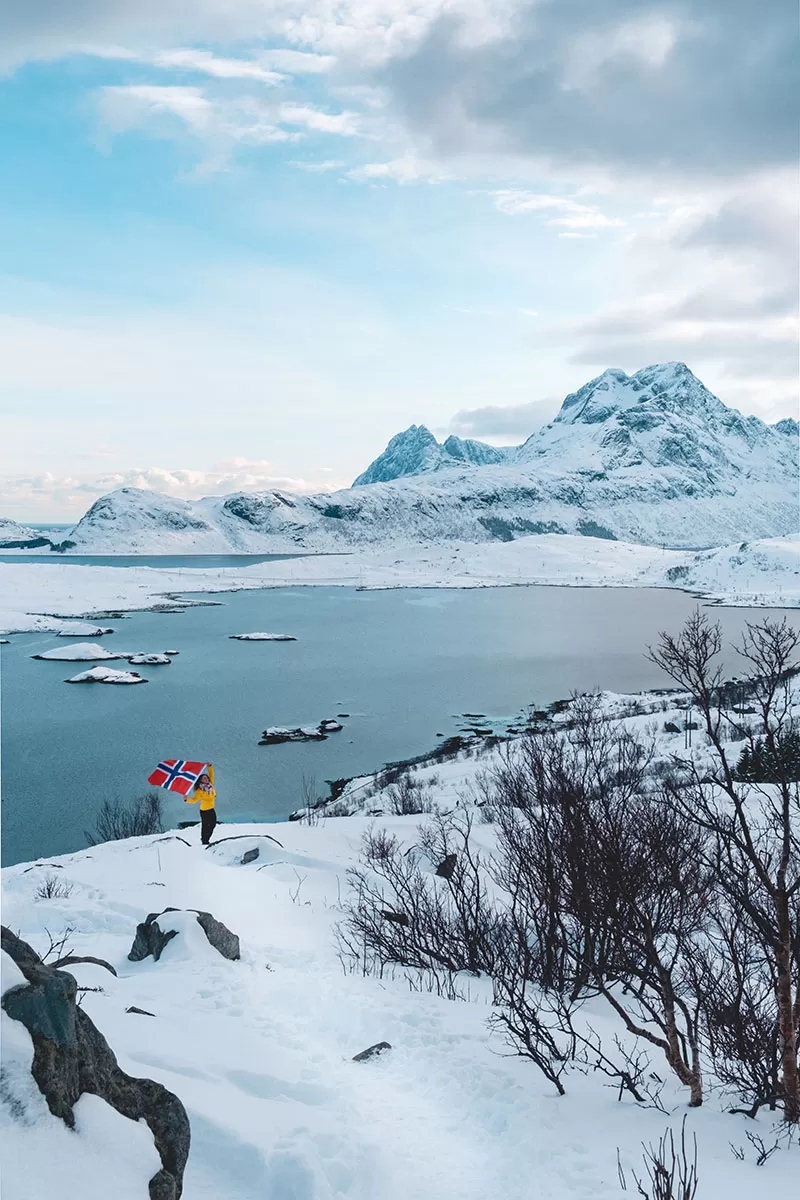
Having said that, the weather can change quickly throughout the day. Its notoriously unpredictable, but the upside is that bad weather usually passes as quickly as it came. Ensure you dress warm and in layers so you can easier find some relief when the sun shines. For ideas on what what to wear and pack, check out my packing Norway guide here.
17. Be extra cautious when driving in winter
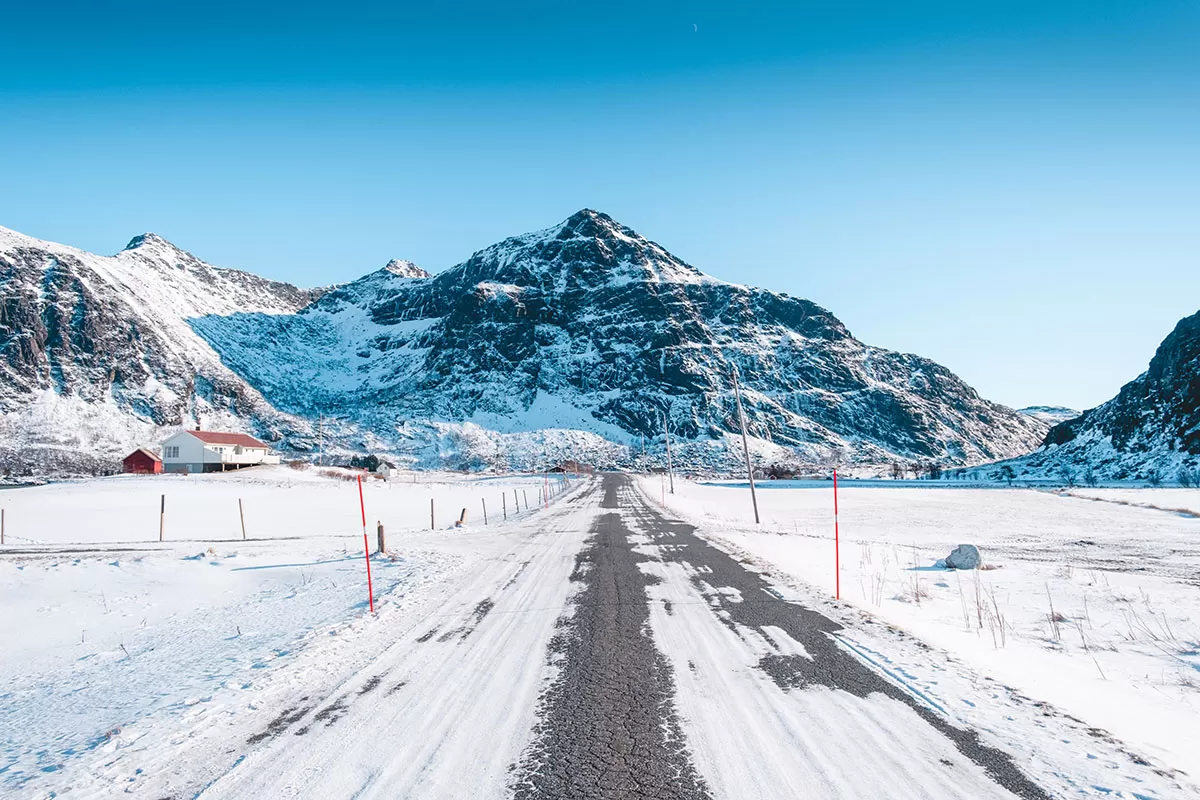
Brøytestikker aka plow sticks, line the roads in winter
If you’ve never driven in the snow before then this one is for you. I’d never driven in snow either before until this trip and I learned a couple of really important things that I didn’t find anywhere else.
Firstly, coastal roads in Norway aren’t as wide as what you may be used to back home. I saw at least 4 cars and a truck that drove too close to the edge and ended up stuck in a ditch on the side of the road. When the snow plows come through and push the snow to the side you can get a false sense of where the road edge is. If you’re unsure, driver a little slower, but be mindful of other drivers behind you and let them pass on designated meeting points, marked with an ‘M’ or at exits to let them pass.
Secondly, look out for brøytestikker (plow sticks), these are bright orange reflective sticks that are placed in snow along all roads. These are your best friend. Look out for them and always drive to the left of them.
If you do get stuck call the recovery service emergency number. Call the NAF (Norges Automobil Forbund), on 08505 from with Norway or 0047 92608505 from abroad.
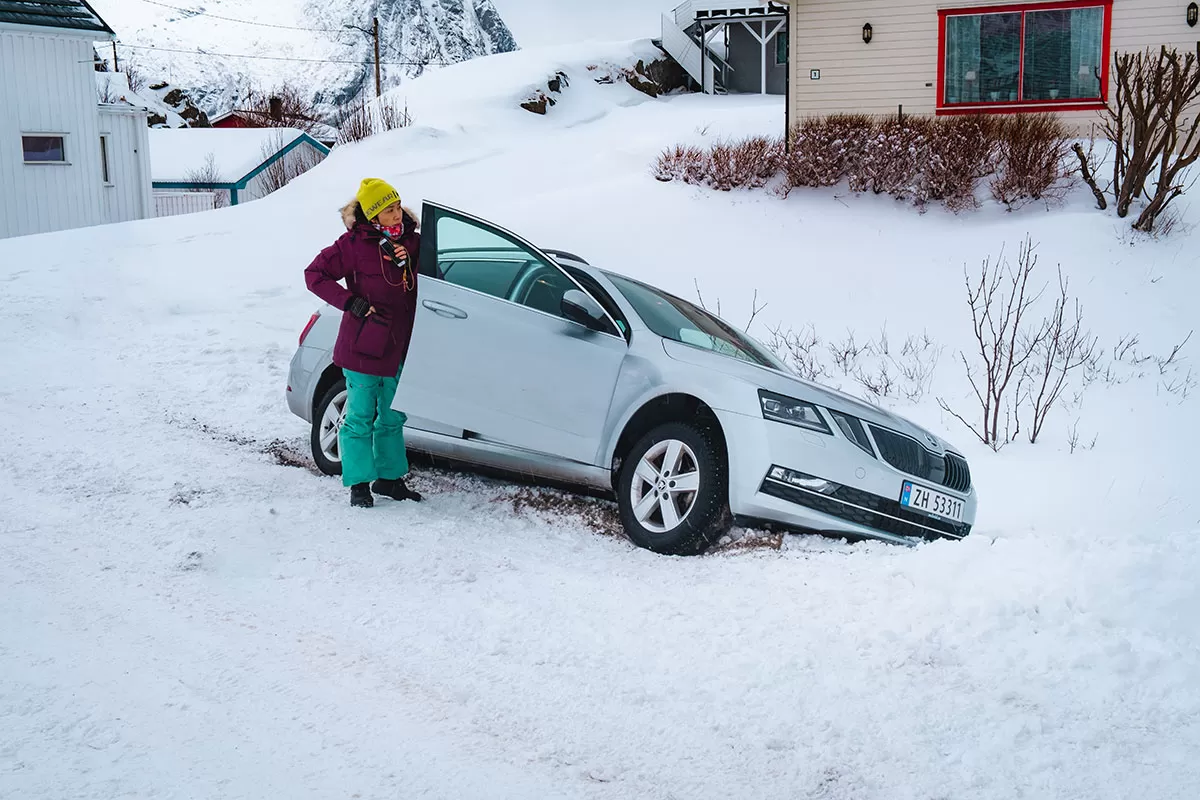
Don’t drive close to the edge or this will happen
18. Use Google Maps. In-car GPS can be unreliable
Whilst all places are easy to find using Google Maps, when driving you’re more likely to use the GPS in your car. The only caveat is that it’s harder to find specific points of interest locations unless you have an address.
I recommend keeping your phone handy to check Google Maps or enter in the lat/long coordinates. As a side note, if you don’t have data, you can still access Google Maps without internet access, just turn your location on so if can track you. You can also download maps to access offline which makes it easier to see where you are.
19. How long should you stay in Lofoten
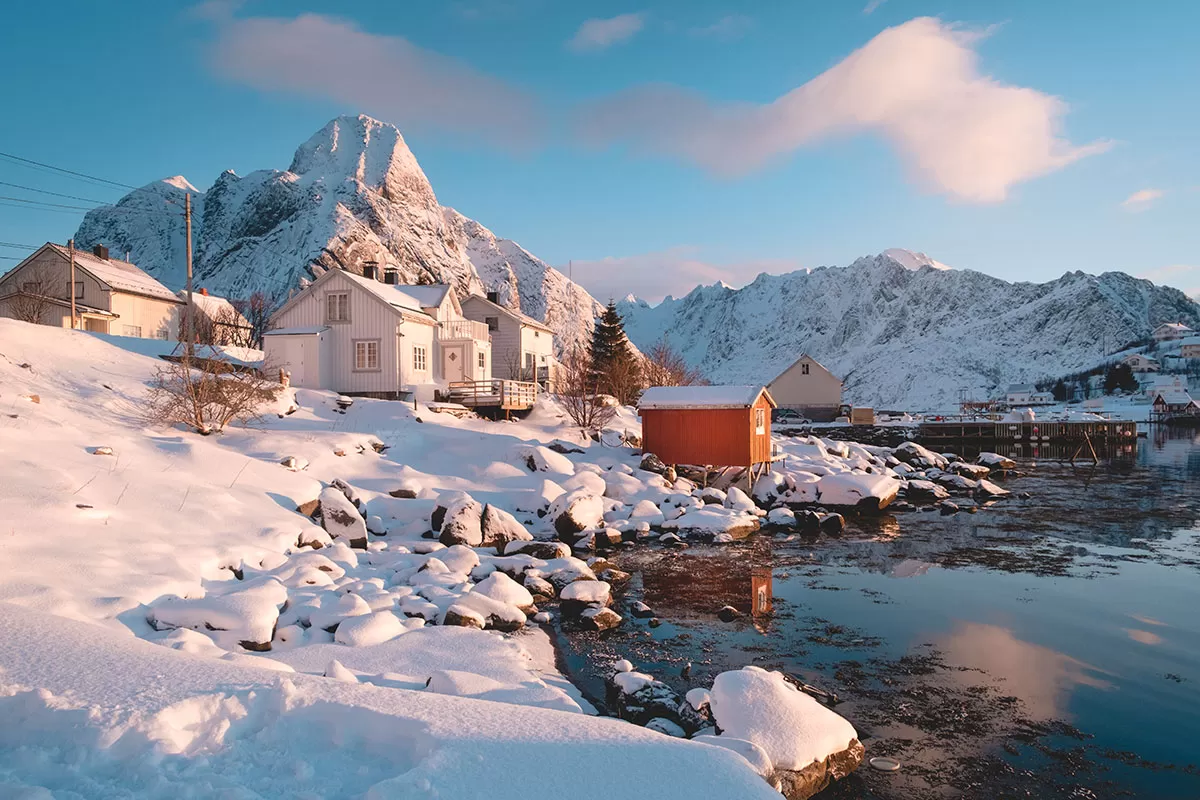
20. Learn how to recycle, Norwegian style
Ok, so this is more of a general Norway tip. If you’re not a master at recycling, then you better learn quick because the Norwegians are world-class recyclers and they expect you to be too!
Even in our small cabin at Eliassen Rorbuer they manage to squeeze in three separate bins underneath the sink for recycling.
Again, this was another learning curve for me. Coming from London where you only have one bag for all recyclable items then another for general waste, the Norwegian’s separate everything!
Here’s how it works. You have to maintain separate bins for different kinds of waste, each with its own specific bag so it’s easier for the waste to be sorted afterwards.
The food and organic leftovers go in a green bag. All plastics must be rinsed thoroughly and go in a blue bag. Paper should be collected in a paper bag and finally, general waste goes in any kind of bag.
But wait, there’s more. Introducing the pant system. The pant system is where you can take all your plastic drink bottles and cans to a pant machine located at any supermarket and claim back ‘pant’. This is the added cost (1-2.5 NOK) that’s applied upon purchase that you can get back. After inserting all your bottles and cans , the machine will issue you with a receipt that you can use to spend in the supermarket or donate to charity via the machine.
21. Locate the nearest petrol station
Lofoten might be a popular destination, but it’s important to remember that it’s still quite rural so petrol stations are only available in the larger towns. Always know where your nearest petrol station is, and fill up when you get the chance and before a long journey.
22. Don’t park on the road
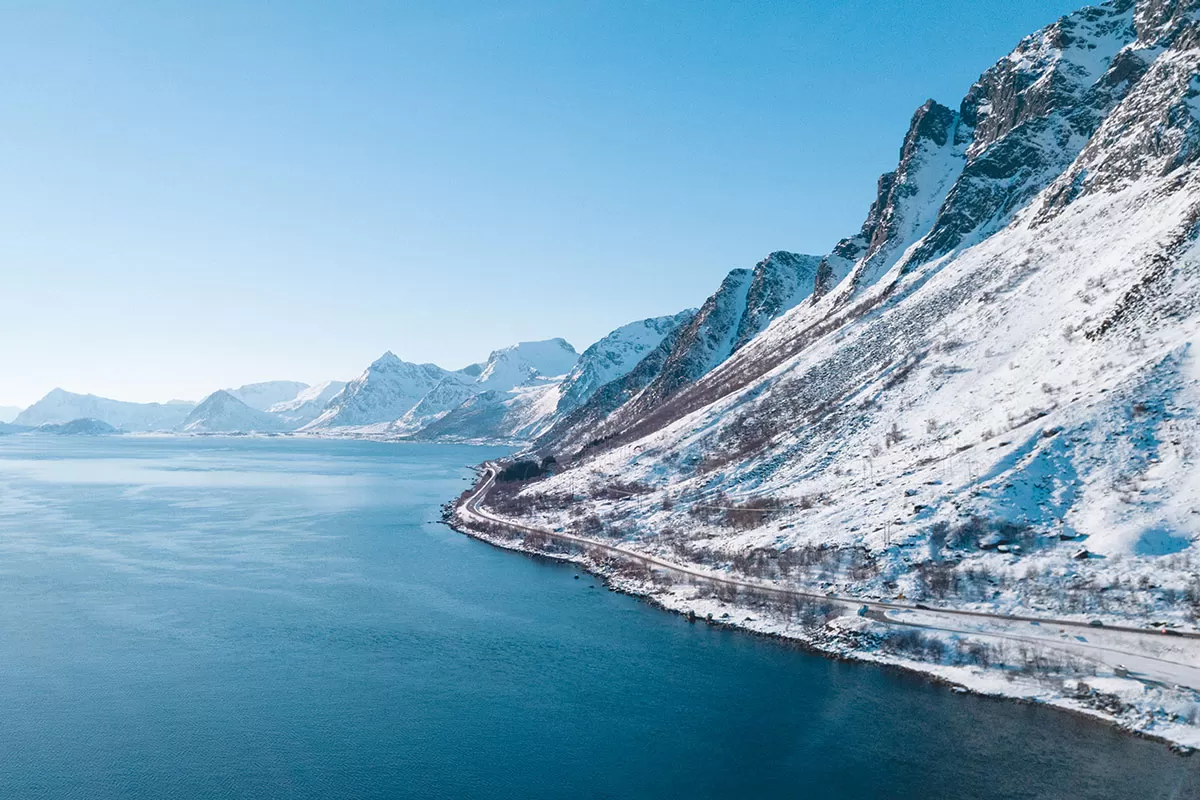
I can’t count the amount of times I saw a spot and wanted to stop immediately and get out. Whether you see the perfect reflection in the calm water or the sun is shining through the clouds just right, it’s in those moments you just want to slam the brakes. But, be careful.
The roads in Lofoten can be narrow with two lanes or single lanes. The coastal roads usually hug a mountain and will have a steep drop on the other side. So, finding a safe spot to stop can be difficult and if no cars are around you’ll be tempted to stop on the road itself and jump out. Please don’t do this.
Be mindful about stopping on corners, blind spots, on single lane roads with a wide pocket to allow for oncoming cars to pass or others to overtake you. Always check there is no one behind you before stopping. If you do stop, pull over to the side of the road and check both directions before crossing the road.
The wide pockets are marked by a blue sign with an M (see page 8) and these are designated Møteplass (Meeting points) not to be confused with meeting points for people, but rather meeting cars that need to pass each other. These Møteplass are found all over Lofoten.
Here is a list of all useful traffic road signs in Norway to get familiar with.
23. Where to stay in Lofoten
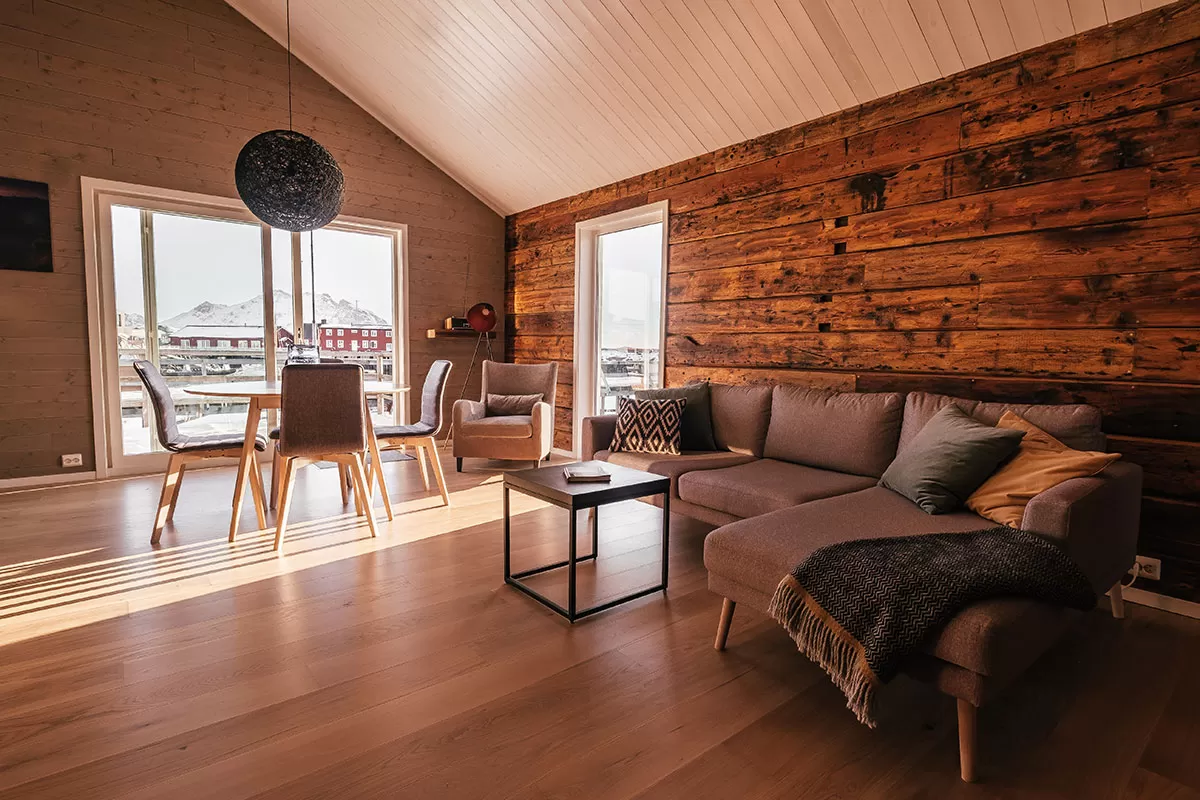
Inside my cabin at Hattvika Lodge
When visiting Lofoten, you have to stay in a rorbuer (fisherman’s cabin) or sjøhus (seahous). All over Lofoten you’ll find vibrant red and yellow rorbuer and sjøhus, as they’re called in Norwegian. Originally, built to house fishermen who would come from all over Norway for the Lofoten fishing season, today these historic buildings have been converted into cosy accommodation for visitors to enjoy and authentic Lofoten experience.
I stayed at the beautiful and family run Hattvika Lodge in Ballstad for 4 nights before continuing further south to stay at the iconic Eliassen Rorbuer for 3 nights and where I ended my trip. Just 30 minutes drive apart, both accommodations are ideally located to use as a base as you travel around the islands.
For more details about my stay, read my review of Hattvika Lodge here and Eliassen Rorbuer.
That’s it! I hope you found this Lofoten travel tips guide useful. If you have any questions, please ask in the comment section below and I’ll get back to you.
Planning a trip and need travel insurance? Get a free quote from World Nomads here.
Recommended tours and experiences
- Discover the beautiful fjords and islands of Lofoten with this kayak adventure in Eggum
- Explore Trollfjord on-board a comfortable sailing catamaran
- Enjoy the pure Arctic on this Sailing, Hiking and Fishing Tour in Lofoten
- Experience Lofoten’s majestic Trollfjord and its white-tailed eagles in complete silence on a hybrid-electric ship
- Henningsvaer Cultural Dinner Cruise Starting from Lofoten
Visiting Norway? Check out my other Norway posts
- 28 Unique Things to Do in Lofoten Before You Die [A Comprehensive Guide]
- Hattvika Lodge Review: Cosy Cabins in the Heart of Lofoten You’ll Never Want to Leave
- Staying at Eliassen Rorbuer: The Most Picturesque Fishing Village in Lofoten, Norway
- How to get to Lofoten: 6 Easy Ways to Get to the Lofoten Islands, Norway
- 49 Underrated Things to Do in Oslo, Norway That Are Totally Worth Doing
- 22 Absolutely Free things to do in Oslo You Shouldn’t Miss
- Emanuel Vigeland Museum: Oslo’s Best-Kept Secret
- How to Hike Trolltunga like a Pro: The Ultimate Guide
- 11 Awesome Things to do in Stavanger you won’t forget
- The Ultimate Sámi Culture Experience in Tromsø
- 7 Reasons Why You Should Take an Arctic Fjords Road Trip in Tromsø
- The Best Place to See the Northern Lights You Probably Haven’t Heard of
- How to Choose the Best Whale Watching Tour in Norway and Iceland
Watch my vlog on the best things to do in Lofoten
Like it? Pin it for later!
Sources / The Rough Guide to Norway
Over to you!
Do you have a question about visiting the Lofoten islands? Ask me below! Let me know using the comments section below or join me on social media to start a conversation.
Thanks for reading and I hope you enjoyed this post.
Like what you see? Subscribe using the form below to have all of my posts delivered directly to your email.

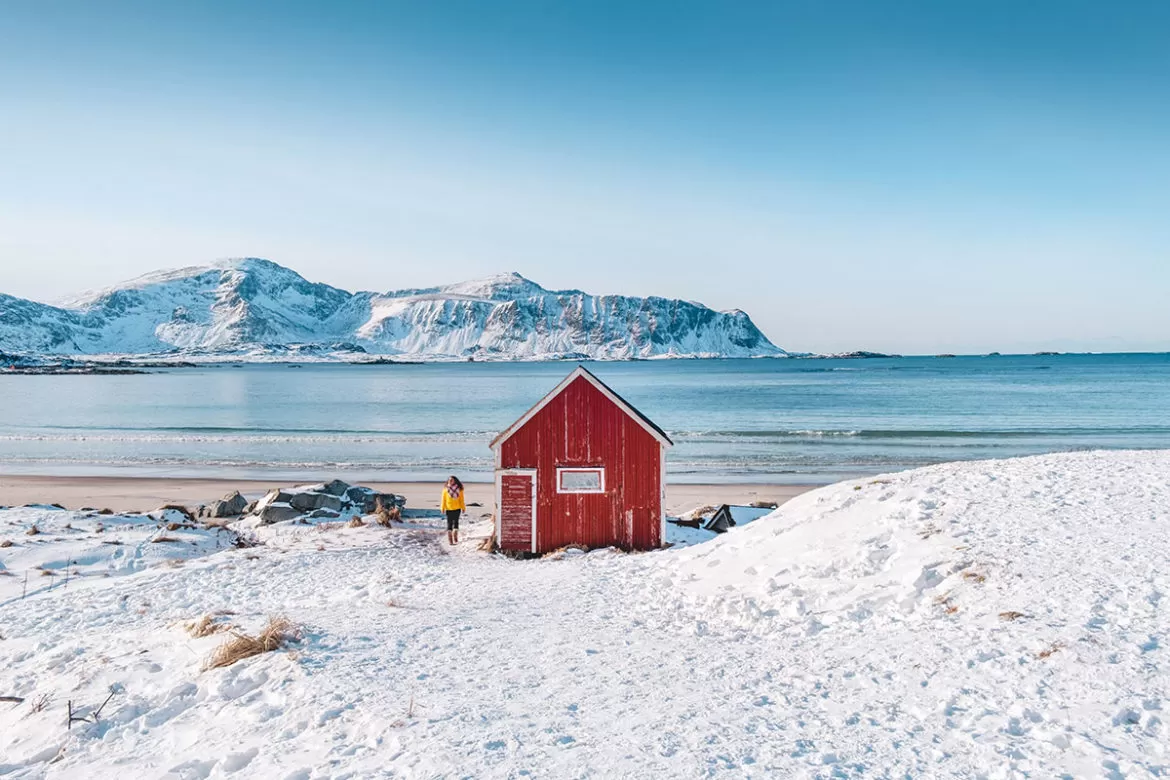
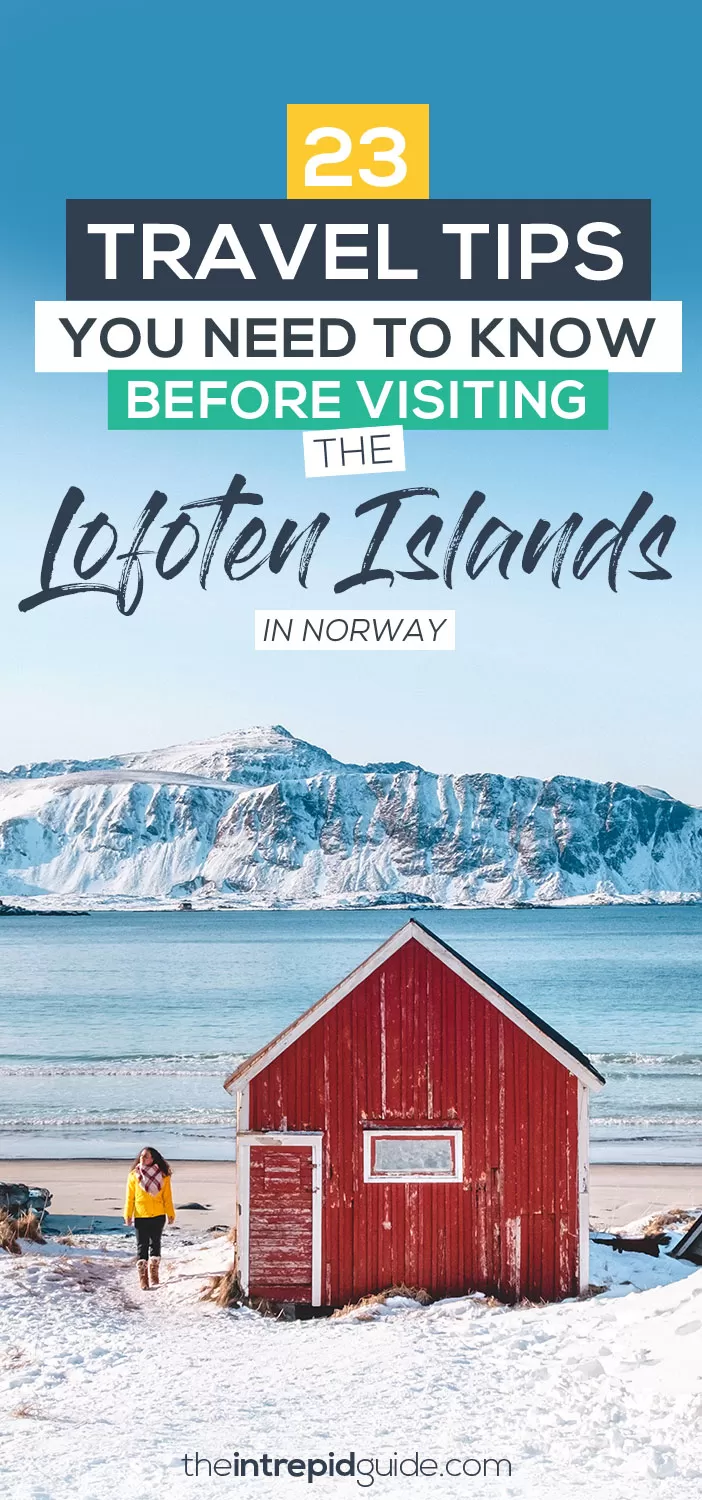
5 comments
I’ll be in Lofoten solo from Dec. 30th 2019 – Jan. 5th 2020 and your tips are the best I’ve read so far. Thank you so much! The driving tips are absolutely invaluable for me because I have not much snow driving experience.
That’s so wonderful to hear. Thank you, Stephanie, for your kind words. Have a wonderful trip! 🙂
Thank you, Stephanie! I’m so glad you found this helpful 🙂 Wishing you an amazing time. Let me know how it goes 🙂
LOVE all your tips, Michele! All so true, and we learned first-hand! I still can’t believe how many cars we saw on the side of the road (usually in a ditch). Road safety really is important, ESPECIALLY when travelling in the winter! 🙂
Thank you so much, Lisa 🙂 Seeing all those stranded cars were definitely unexpected and something we don’t hear enough about for sure.